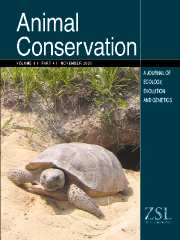Article contents
Taxonomic bias in reintroduction projects
Published online by Cambridge University Press: 22 February 2005
Abstract
Taxonomic bias has been documented in general science and conservation research publications. We examined whether taxonomic bias is similarly severe in actual conservation programmes as indicated by the focus of species reintroduction projects worldwide. We compiled a database of reintroduction projects worldwide, yielding a total of 699 species of plants and animals that are the focus of recent, current or planned reintroductions. Using IUCN (World Conservation Union) data for total numbers of known species worldwide, we found that vertebrate projects were over-represented with respect to their prevalence in nature. Within vertebrates, mammals and, to a lesser extent, birds, were over-represented, whereas fish were under-represented. This over-representation extended to two mammal orders, artiodactylids and carnivores, and to four bird orders, anseriforms, falconiforms, gruiforms and galliforms. For neither mammals nor birds was reintroduction project bias related to any differences between orders in vulnerability to threat. Bird species that are the focus of reintroduction efforts are more likely to be categorised as ‘Threatened’ than expected on the basis of the distribution of all known species over all threat categories, however, nearly half of all bird species being reintroduced are classified as ‘Least Concern’. The selection of candidates for reintroduction programmes is likely to consider national priorities, availability of funding and local community support, over global conservation status, While a focus on charismatic species may serve to garner public support for conservation efforts, it may also divert scarce conservation resources away from taxa more in need of attention.
- Type
- Research Article
- Information
- Copyright
- 2005 The Zoological Society of London
- 204
- Cited by


